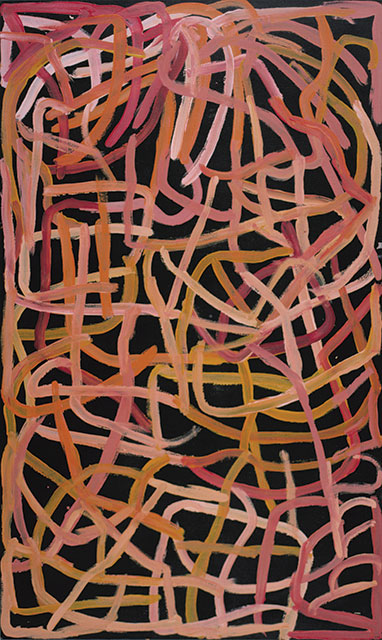


During her seven-year career as a painter of canvases, at the end of a long life, Emily Kame Kngwarreye became one of the most celebrated of all Australian artists. Her enormous œuvre (around 3,000 paintings) was the product of her dogged physical strength, fecund visual imagination, and the demands placed on her by two groups: her remote Central Australian Indigenous community at Utopia, to which she was a great provider; and the art dealers who fed a western market insatiable for her strongly patterned abstractions.
In the few statements she made on her art,1 Kngwarreye made clear that she painted to maintain and interpret her country, its bountiful bush foods, and the sacred stories attached to plants and animals in their spirit guise. She said: '[My paintings are the] whole lot, that's all, whole lot, awelye (my dreaming), arlatyeye (pencil yam), arkerrthe (mountain devil lizard), ntange (grass seed), tingu (dog), ankerre (emu), intekwe (plant, emu food), atnwerle (green bean), and yam seed. That's what I paint, whole lot ...'2 Kngwarreye had long painted in ochres on the torsos of her clanswomen as preparation for ceremony. In 1978 she became a member of the Utopia women's group using batik dyes to decorate long silk shawls in which her 'fantastic sense of all-overness, a kind of rushing energy' was first apparent.3 During a summertime painting project instigated by Rodney Gooch at Utopia in 1989, Kngwarreye converted to painting on canvas, and up to her death in 1996 created several distinct painterly styles: loose grids overlaid with tiny dots, pure screens of dots, the multicoloured stippled tracks of her 'dump-dump' style, and the gestural linear manner of her last year and a half.
Kame colour VI (1995) exemplifies the latter style. The artist painted on unstretched canvas laid directly on the ground at Utopia Station, working in from the edges, seated cross-legged and reaching into the black field with a long brush. Like most Central Desert painting, the work has no right way up. From Kngwarreye's perspective the subject had rich mythic meaning, but she did not reveal the Yam story. The plant itself is a prized food-source, retrievable by women skilled in reading the signs of its hidden presence and armed with long digging-sticks. Emily's pink and orange brushstrokes—graceful in profile but tense in execution—are thought to relate to the growth patterns of the yam roots under the ground and the way the ground cracks in certain places when the tuber is ripe for gathering.
Other versions of the subject, including Kngwarreye's masterpiece Big Yam Dreaming (1995), were painted in a network of white strokes over a black ground. The analogy has been made to strokes of bright paint laid onto the dark skin of Anmatyerr women 'painting up' for ceremonial purposes (or aweyle). The colours of Kame colour VI are indeed close to the yellow and red ochres of body painting. This analogy serves to reinforce the fact that although Kngwarreyes's practice was cast in the modern idiom of abstract painting on canvas made to be hung on a wall (most likely in a distant urban home or gallery), its vital source was in ancient religious belief, and a sense of pattern nourished by observing the growth of things in her own country, alhalker.
- Roger Benjamin
For further reading on the life and work of Emily Kame Kngwarreye, visit the National Museum of Australia website.